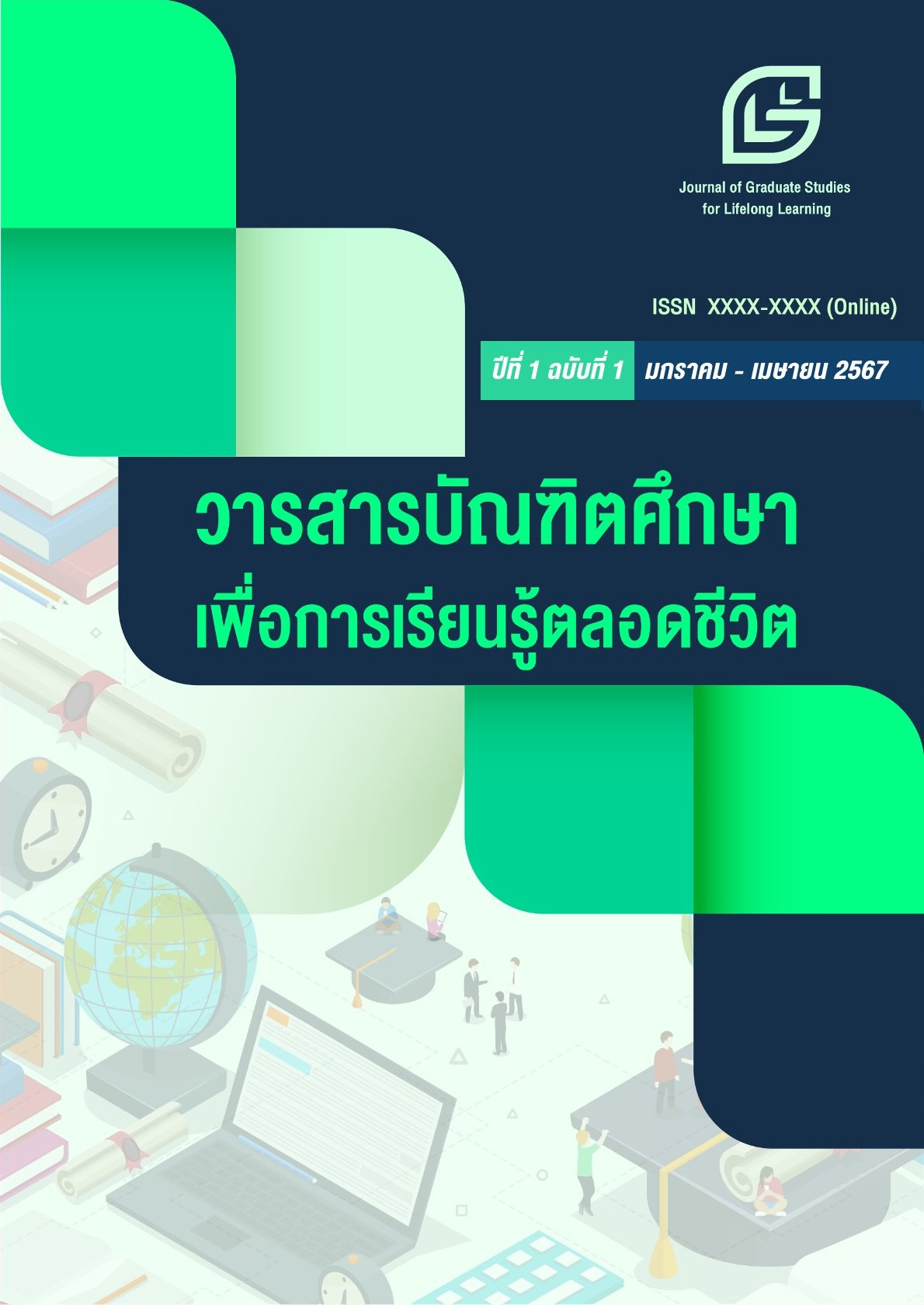Development of post operative pain management model for elderly with hip fracture Thabo Crown Prince Hospital
Main Article Content
Abstract
This research and development aims to developing a model for managing postoperative pain in elderly hip fracture patients. The sample group is There were 7 professional nurses and 20 elderly people after hip fracture surgery. The research tools were divided into 3 phases: 1) the phase before developing the model. It is a question line to study the situation of pain management after surgery in elderly people with hip fractures 2) the format development phase, including (1) a post-operative pain assessment record form and (2) Isaan traditional music to reduce pain, and 3) the results evaluation stage, including (1) the satisfaction assessment form. Satisfaction of professional nurses, (2) satisfaction assessment form of the elderly in pain management, (3) satisfaction assessment form of the elderly listening to Isaan traditional music to reduce pain, and (4) guidelines for questions in mobilization group meetings. brain The research was conducted between January 2024 and April 2024. The qualitative data were analyzed using content analysis. and quantitative data were analyzed using descriptive statistics.
The results of the study found that the postoperative pain management situation before developing the model had an issue: there was no postoperative pain management model. There are no tools to assess pain. and lack of continuity in pain management evaluations as a result, pain management by nurses is not effective enough. After developing the postoperative pain management model, it consists of 1) the principles of the model, 2) the structure of the model, including the team, location, and 3) guidelines for postoperative pain management. and results of care according to the postoperative pain management model It was found that nurses who used the model were most satisfied with the postoperative pain management model. Satisfaction of post-surgery elderly people who receive post-surgery pain management. It was found that the majority of the elderly were satisfied at the highest level in all aspects. And elderly people after hip fracture surgery who listened to the use of Isaan music to reduce pain had the highest level of satisfaction. Accounting for 90 percent
Article Details

This work is licensed under a Creative Commons Attribution-NonCommercial-NoDerivatives 4.0 International License.
References
กนกวรรณ ใจภักดี, กนกพร นทีธนสมบัติ และพรศิริ พันธสี. (2559). ผลของโปรแกรมการจัดการอาการปวดโดย ใช้สุวคนธบำบัด ร่วมกับดนตรีบำบัดในผู้ป่วยหลังผ่าตัดใส่เหล็กยึดตรีงกระดูกขา. วารสารโรงพยาบาลเจริญกรุงประชารักษ์, 12(2), 54-68.
กระทรวงสาธารณสุข, กรมการแพทย์, สำนักการพยาบาล. (2550). มาตรฐานการพยาบาลในโรงพยาบาล ปรับปรุงครั้งที่ 2 (พิมพ์ครั้งที่ 3). องค์การสงเคราะห์ทหารผ่านศึก.
จิณพิชญ์ชา มะมม. (2562). การพยาบาลผู้ป่วยโรคกระดูกและข้อ (พิมพ์ครั้งที่ 2 แก้ไขเพิ่มเติม). มหาวิทยาลัยธรรมศาสตร์.
ชิษณุพงค์ อินทร์แก้ว. (2565). การใช้เสียงเพื่อบรรเทาความเจ็บปวด : กรณีศึกษาในดนตรีบำบัดและดนตรี พิธีกรรม. วารสารศิลปกรรมศาสตร์ มหาวิทยาลัยขอนแก่น, 14(2), 300-318.
ดวงสุดา วัฒนธัญญการ, บัวหลวง สำแดงฤทธิ์ และนิโรบล กนกสุนทรรัตน์. (2561). การประเมินการใช้แนวปฏิบัติการจัดการความปวดในผู้ป่วยที่ได้รับการผ่าตัดทางกระดูกและข้อ. วารสารการพยาบาลและการดูแลสุขภาพ, 36(4), 100-109.
นัทธี เชียงชะนา และสมชัย ตระการรุ่ง. (2558). วิธีการบำบัดทางดนตรี: การวิเคราะห์เนื้อหาจากงานวิจัย. วารสารสาธารณสุขศาสตร์, 45(2), 116-133.
บุญนำ พัฒนแก้ว. (2562). คุณภาพชีวิตผู้ป่วยกระดูกสะโพกหักหลังได้รับการผ่าตัดใส่ข้อสะโพกเทียม. มหาราชนครศรีธรรมราช เวชสาร, 2(2), 21-30.
พัชราพร ตาใจ, บุญญภักดิ์ เห่งนาเลน และเยาวลักษณ์ สงวนพานิช. (2563). กระดูกสะโพกหักในผู้สูงอายุ: บทบาทพยาบาลในการป้องกันการเกิดภาวะแทรกซ้อน ก่อนและหลังผ่าตัดกระดูกสะโพก. วารสารมหาวิทยาลัยคริสเตียน, 26(4), 116-128.
พุทธิพร พิธานธนานุกูล และปัทมา สุริต. (2554). การจัดการความปวดเรื้อรังของผู้สูงอายุที่อาศัยอยู่ในชุมชน. วารสารการพยาบาลและการดูแลสุขภาพ, 29(4), 58-68.
เรณู ภูจอมจิตตฏ์ มิ่งพันธ์, ตะวัน เขตปัญญา, เยาวเรศ ก้านมะลิ และวารุณี เข็มลา. (2563). การพัฒนาแนวปฏิบัติการพยาบาลการจัดการความปวดในผู้สูงอายุที่ได้รับการผ่าตัดข้อสะโพกเทียม. วารสารคณะพยาบาลศาสตร์ มหาวิทยาลัยบูรพา, 28(2), 1-15.
โรงพยาบาลสมเด็จพระยุพราชท่าบ่อ. (2566). รายงานสถิติผู้ป่วยกระดูกสะโพกหักที่ได้รับการรักษาโดยการผ่าตัด. โรงพยาบาลสมเด็จพระยุพราชท่าบ่อ.
ลำดวน มีภาพ, ดลวิวัฒน์ แสนโสม และนงลักษณ์ เมธากาญจนศักดิ์. (2560). แนวปฏิบัติการพยาบาลในการจัดการความปวดเฉียบพลันในผู้ป่วยวิกฤตหอผู้ป่วยวิกฤตอายุรกรรม. ศรีนครินทร์เวชสาร, 32(6), 562-570.
วัชรี มุกด์ธนะอนันต์. (2555). การพัฒนารูปแบบการจัดการความปวดในผู้ป่วยหลังผ่าตัด. วารสารการแพทย์ โรงพยาบาลศรีสะเกษ สุรินทร์ บุรีรัมย์, 27(2), 16-172.
วิภาพร ลีเลิศมงคลกุล, สุพร ดนัยดุษฎีกุล, วัลย์ลดา ฉันท์เรืองวณิชย์ และพัชรพล อุดมเกียรติ. (2556). ความสัมพันธ์ระหว่างดัชนีมวลกาย ความเจ็บปวด และการสนับสนุนทางสังคม กับการปฏิบัติกิจวัตรประจำวัน ใน ระยะฟื้นตัว ในผู้ป่วยผ่าตัดเปลี่ยนข้อสะโพกเทียม. วารสารพยาบาลศาสตร์, 31(2), 26-37.
ศิริเอมอร วิชาชาติ. (2552). การพัฒนารูปแบบการจัดการความปวดหลังผ่าตัดทางออร์โธปิดิกส์ ในหอพิเศษพระปทุมวรราชสุริยวงศ์ 1 โรงพยาบาลสรรพสิทธิประสงค์ จังหวัดอุบลราชธานี [วิทยานิพนธ์ปริญญามหาบัณฑิต ไม่ได้ตีพิมพ์]. มหาวิทยาลัยขอนแก่น.
ศรีสุดา งามขำ, นิสา ครุฑจันทร์, จุฑารัตน์ สว่างชัย, บุญเตือน วัฒนกุล, ศศิธร ชิดนายี และรุ่งนภา เขียวชอ่ำ. (2561). ความรู้เกี่ยวกับการประเมินและการจัดการกับความปวดของพยาบาลไทย. วารสารการพยาบาลและการดูแลสุขภาพ, 36(1), 81-89.
สุวิมล แคล่วคล่อง, วัลย์ลดา ฉันท์เรืองวณิชย์ และสุพร ดนัยดุษฎีกุล. (2557). ความสัมพันธ์ระหว่างภาวะโรคร่วม ความแข็งแรงของกล้ามเนื้อในการกำมือ และความวิตกกังวล กับการฟื้นตัวด้านการทำหน้าที่ของผู้ป่วยกระดูกสะโพก หักภายหลังผ่าตัด. วารสารสภาการพยาบาล, 29(2), 36-48.
อรพรรณ โตสิงห์. (2559). การพยาบาลผู้ป่วยทางออร์โธปิดิกส์. โครงการตำราคณะพยาบาลศาสตร์ มหาวิทยาลัยมหิดล.
อัญชลี คันธานนท์. (2556). การพยาบาลผู้สูงอายุกระดูกข้อสะโพกหักที่มีโรคเรื้อรังร่วมด้วย : กรณีศึกษา. วารสารวิชาการแพทย์เขต 11, 7(2), 271-280.
Folbert, E. C., Hegeman, J. H., Gierveld, R., van Netten, J. J., Velde, D. V., Ten Duis, H. J., & Slaets, J. P. (2017). Complications during hospitalization and risk factors in elderly patients with hip fracture following integrated orthogeriatric treatment. Arch Orthop Trauma Surg, 137, 507-515. https://doi.org/10.1007/s00402-017-2646-6
Kanis, J. A., Oden, A., McCloskey, E. V., Johansson, H., Wahl, D. A., Cooper, C., & IOF Working Group on Epidemiology and Quality of Life. (2012). A systematic review of hip fracture incidence and probability of fracture worldwide. Osteoporosis International, 23, 2239-2256. https://doi.org/10.1007/s00198-012-1964-3
McCafery, M. (1979). Nursing management of the patient with pain (2 ed.). Lippincott.
Peeters, C. M., Visser, E., Van de Ree, C. L., Gosens, T., Den Oudsten, B. L., & De Vries, J. (2016). Quality of life after hip fracture in the elderly: A systematic literature review. International Journal of the Care of the Injury, 47(7), 1369-1382. https://doi.org/10.1016/j.injury.2016.04.018
Sassoon, A., D'Apuzzo, M., Sems, S., Cass, J., & Mabry, T. (2013). Total hip arthroplasty for femoral neck fracture: Comparing in-hospital mortality, complications, and disposition to an elective patient population. The journal of Arthroplasty, 28(9), 1659-1662. https://doi.org/10.1016/j.arth.2013.01.027
Wall, P. D., & Melzack, R. (1999). Textbook of Pain (4th ed.). Churchil Livingstone.


